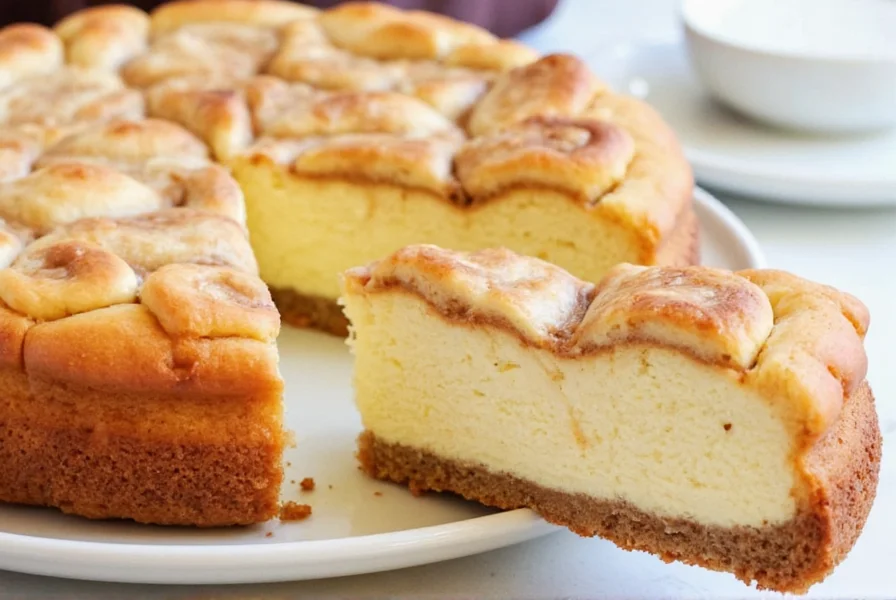The cinnamon roll honey bun cheesecake represents an innovative fusion of three beloved dessert categories. Unlike traditional cinnamon rolls that rely solely on cinnamon-sugar filling, this hybrid incorporates honey as a primary sweetener while introducing a cheesecake component that adds richness and tang. The result is a dessert with complex flavor layers: the familiar warmth of cinnamon, the distinctive floral sweetness of honey, and the creamy richness of cheesecake.
Understanding the Hybrid Dessert Concept
This creative dessert emerged from the trend of combining popular bakery items into single offerings. While cinnamon rolls and honey buns share similar dough bases, the addition of cheesecake transforms the texture profile significantly. The honey bun element typically replaces the traditional brown sugar filling with honey-based syrup, while the cheesecake component is either swirled through the dough or layered on top.
Key Characteristics and Flavor Profile
What distinguishes a true cinnamon roll honey bun cheesecake from similar desserts? Three essential elements define this hybrid:
| Element | Traditional Version | Cinnamon Roll Honey Bun Cheesecake Variation |
|---|---|---|
| Dough Base | Enriched yeast dough | Honey-enriched yeast dough with subtle vanilla notes |
| Filling | Cinnamon-sugar mixture | Honey-cinnamon swirl with brown sugar |
| Special Component | None | Cheesecake ribbon or topping layer |
| Finishing Glaze | Cream cheese frosting | Honey-vanilla glaze with optional cream cheese swirl |
The flavor profile balances sweet, tangy, and spicy notes. The honey provides a more complex sweetness than standard sugar, while the cheesecake element introduces a subtle tang that cuts through the richness. The cinnamon remains prominent but works in harmony with the other flavors rather than dominating.
Commercial Availability and Homemade Versions
Cinnabon first introduced their version as a limited-time offering, creating significant consumer interest. While not consistently available at all locations, many bakeries have developed their own interpretations of this hybrid dessert. For home bakers, creating a cinnamon roll honey bun cheesecake involves adapting traditional cinnamon roll techniques with specific modifications:
- Substituting honey for some sugar in the dough
- Creating a honey-cinnamon filling instead of standard cinnamon-sugar
- Incorporating a cheesecake component either as a swirl or topping
- Using a honey-based glaze instead of traditional cream cheese frosting
Recipe Considerations for Home Preparation
When attempting to recreate this dessert at home, several technical considerations affect the final product's success. The moisture content from both the honey and cheesecake components requires careful balancing to prevent a soggy texture. Professional bakers recommend:
- Reducing liquid content slightly in the dough to compensate for honey's moisture
- Using full-fat cream cheese for the cheesecake element to maintain structure
- Applying the honey glaze after the rolls have cooled slightly to prevent absorption
- Allowing proper resting time for flavors to meld before serving
Temperature control proves critical when working with the cheesecake component. Adding it to dough that's too warm can cause separation, while adding it to cold dough may create texture inconsistencies. The ideal approach involves preparing the cheesecake mixture at room temperature and incorporating it when the rolled dough has rested for precisely 10-15 minutes.
Serving Suggestions and Pairings
This dessert shines when served slightly warm, allowing the honey glaze to become beautifully glossy and the cheesecake element to soften. Perfect pairings include:
- Bold coffee varieties that complement the honey sweetness
- Vanilla ice cream for an indulgent à la mode presentation
- Fresh berries to provide a tart contrast to the sweetness
- Whipped cream infused with complementary flavors like bourbon or vanilla bean

Storage and Shelf Life Considerations
Due to its multiple components, this hybrid dessert has specific storage requirements. The cheesecake element makes it more perishable than standard cinnamon rolls. For optimal freshness:
- Store in an airtight container at room temperature for up to 24 hours
- Refrigerate for longer storage (up to 5 days), though this affects texture
- Avoid freezing the complete assembled product; freeze components separately
- Reheat gently in a low-temperature oven to restore optimal texture
Understanding the science behind each component helps bakers troubleshoot common issues. For instance, honey's hygroscopic nature means it attracts moisture, which can make the rolls soggy if not properly balanced with other ingredients. Similarly, the cheesecake element requires precise baking temperatures to prevent cracking or curdling.
What makes a cinnamon roll honey bun cheesecake different from regular cinnamon rolls?
The key differences include honey as the primary sweetener instead of sugar, a cheesecake component either swirled through the dough or layered on top, and a honey-based glaze rather than traditional cream cheese frosting. The texture is richer and more complex due to these combined elements.
Can I make cinnamon roll honey bun cheesecake without a stand mixer?
Yes, you can make it without a stand mixer. While a mixer simplifies the dough preparation, you can knead the enriched dough by hand. The cheesecake component also mixes easily with a hand mixer or even vigorous stirring with a whisk. The process will require more physical effort but produces equally delicious results.
Why does my homemade version turn out too soggy?
Sogginess typically occurs because honey attracts moisture. To prevent this, reduce liquid content slightly in the dough, ensure proper baking time to set the structure, and apply the glaze only after the rolls have cooled slightly. Using full-fat cream cheese for the cheesecake component also helps maintain structure.
How can I adapt this recipe for dietary restrictions?
For gluten-free versions, use a quality gluten-free flour blend designed for yeast baking. Dairy-free adaptations work with plant-based cream cheese alternatives and non-dairy milk. For reduced sugar, maintain some honey for flavor but reduce the amount, understanding this will affect texture and browning.










 浙公网安备
33010002000092号
浙公网安备
33010002000092号 浙B2-20120091-4
浙B2-20120091-4